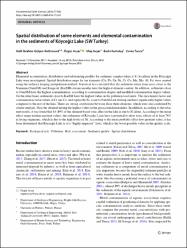Spatial distribution of some elements and elemental contamination in the sediments of Koycegiz Lake (SW Turkey)
Abstract
Elemental accumulation, distribution and relationship profiles for sediment samples taken at 81 localities in the Koycegiz Lake were investigated. Spatial distribution maps for ten elements (Cu, Pb, Zn, Ni, Cr, Co, Mn, Mo, Al, Fe) were created using the ordinary kriging interpolation method. Statistical tests revealed that the sediments taken from areas close to the Namnam (NamSM) and Kargicak (KarSM) stream mouths have the highest element content. In addition, sediments close to NamSM have the highest contamination, according to contamination degree and modified contamination degree values. On the other hand, sediments close to KarSM have the highest value on the pollution load index. The enrichment factor and contamination factor values of Cr and Co, and especially Ni, close to NamSM are striking and have significantly higher values compared to the rest of the lake. There are strong correlations between these three elements, which were also confirmed by cluster analysis. Ni is the element having the highest value on the geoaccumulation index. In addition, according to the toxic unit results, it was found that 84-89% of the element-based toxic effect in the lake is due to Ni alone. According to the mean effect range median quotient values, the sediments of Koycegiz Lake have a potential to show toxic effects of at least 76% in living organisms, which is due to the high levels of Ni. According to the mean probable effect low quotient value, it has been determined that Koycegiz Lake is at a "highly impacted" level, which is the worst possible value on the quality scale.


















